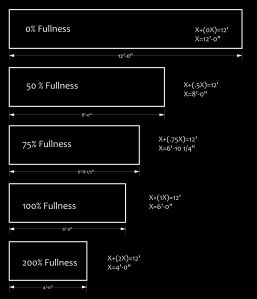Stage Drapes and Fullness Calculations
I blogged a couple of years ago about the Kennedy Center American College Theatre Festival (KCACTF) Region 5 festival and the event that I began running at the region 5 festival a couple of years ago. The event is called Stage Crew Showdown. This year it was held on the campus of The University of Nebraska in Lincoln Nebraska on Sunday, January 20 and Monday, January 21. The event consists of teams of 4 students representing their schools who face off in relay-race style heats performing tasks common to various areas of technical theatre. Events include hanging, and focussing a lighting instrument, tying knots, a costume quick-change, a prop setup-relay race, and cutting tie lines and hanging a border at the correct fullness. It is the last event that is the subject of today’s blog.
The event description for the event follows:
- Teams are provided with a border of a specific width and a specific length of tie line.
- Team members will cut the tie line into the correct number of equal lengths.
- The ties will be properly attached to the border
- the border will be tied onto a batten, centered and with the required fullness tied in.
- The fullness is chosen by the judges immediately prior to the event and may include %50, %75, or %100.
- The event is timed, then seconds are added to the score based upon the following deficiencies (if any apply)
- Major Evaluation Criteria: Tool safety, Attachment process, Conformity of tie-line lengths, Placement with appropriate fullness on batten, Completion of task
This year, I committed to providing all competitors with pdf scans of the judges’ official score sheets so that they might learn from mistakes to improve future performance. I did so earlier this week. One of the team leaders requested clarification on the matter of fullness. Particularly, this team leader was frustrated by the lack of information on how to calculate fullness in the literature. Neither the Backstage Handbook nor any of the standard texts reportedly contain such information. I responded to her with the following email (text paraphrased below)


Leave a comment